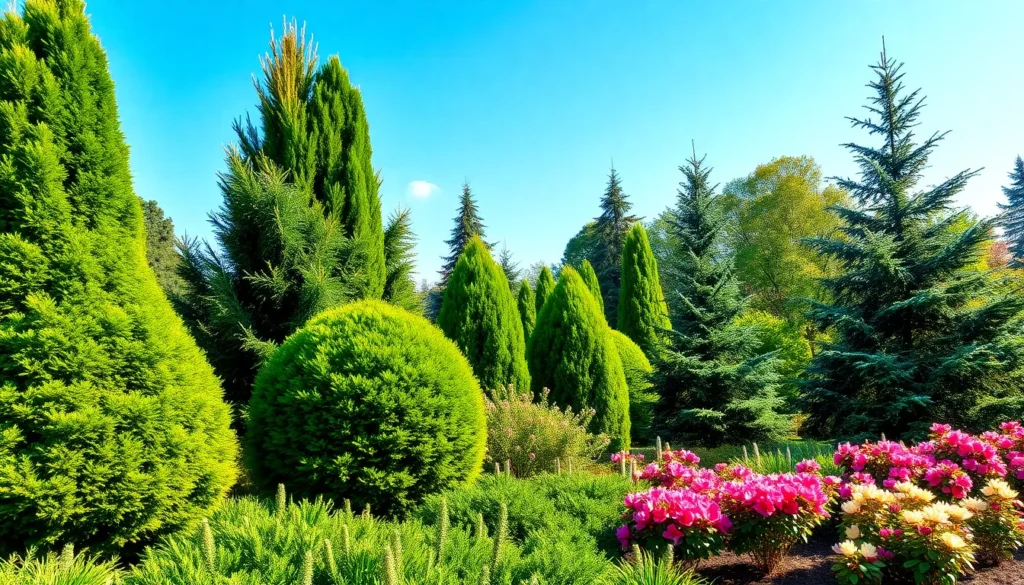We’ve all experienced that disappointing moment when winter arrives and our once-vibrant industry turns into a barren wasteland. While deciduous trees shed their leaves and perennial flowers disappear underground, evergreen plants continue to provide structure, color, and life to our outdoor spaces throughout the year.
Evergreen landscaping isn’t just about survival—it’s about creating a foundation that transforms your property into a year-round masterpiece. These resilient plants offer incredible versatility, from towering conifers that create dramatic focal points to compact shrubs that define borders and pathways. Whether you’re dealing with harsh winters or simply want to reduce seasonal maintenance, evergreens deliver consistent beauty with minimal effort.
The best part? Today’s evergreen varieties go far beyond traditional green needles. We’re talking about plants with golden foliage, silvery textures, and even colorful berries that add visual interest when everything else has gone dormant. Ready to discover which evergreen champions deserve a spot in your industry?
Choose Low-Maintenance Evergreen Shrubs for Year-Round Structure
Evergreen shrubs deliver the perfect balance of beauty and practicality for your landscaping needs. We’ve selected three standout options that require minimal care while providing maximum visual impact throughout every season.
Boxwood for Formal Hedges and Borders
Boxwood shrubs create elegant formal hedges that define garden spaces with classic sophistication. These dense, compact evergreens maintain their rich green foliage year-round and tolerate frequent pruning without stress. Common boxwood (Buxus sempervirens) grows 4-6 feet tall and works perfectly for property borders, while dwarf varieties like ‘Green Gem’ stay under 2 feet for pathway edging.
Maintenance requirements stay minimal with boxwood since they’re naturally slow-growing and drought-tolerant once established. We recommend planting them in well-draining soil with partial shade to full sun exposure. Their small, glossy leaves create a uniform texture that responds beautifully to shaping, making them ideal for topiary work or geometric garden designs.
Juniper Varieties for Ground Cover and Accent Plants
Juniper evergreens offer incredible versatility with over 60 species ranging from low-spreading ground covers to tall accent specimens. Blue Rug Juniper (Juniperus horizontalis ‘Wiltonii’) spreads 6-8 feet wide while staying only 4 inches tall, creating excellent erosion control on slopes. Skyrocket Juniper grows 15-20 feet tall but only 2-3 feet wide, making it perfect for narrow spaces or dramatic vertical elements.
Drought tolerance makes junipers particularly valuable for xeriscaping and low-water landscapes. These hardy evergreens thrive in poor soils and extreme temperatures, requiring virtually no supplemental watering after their first year. Their needle-like foliage comes in colors ranging from blue-green to golden yellow, adding textural interest to any industry design.
Rhododendrons for Colorful Blooms and Dense Foliage
Rhododendron evergreens combine year-round structure with spectacular spring flowering displays. These broad-leafed evergreens produce clusters of vibrant blooms in colors including pink, red, purple, white, and yellow from March through June. Compact varieties like ‘PJM’ reach 3-6 feet tall, while larger species can grow 8-12 feet for dramatic backdrop plantings.
Acidic soil conditions help rhododendrons thrive, making them perfect companions for azaleas and camellias in woodland gardens. We suggest planting them in locations with morning sun and afternoon shade to prevent leaf scorch. Their thick, leathery leaves provide excellent privacy screening while their shallow root systems make them easy to establish in existing landscapes.
Select Evergreen Trees That Provide Privacy and Windbreaks
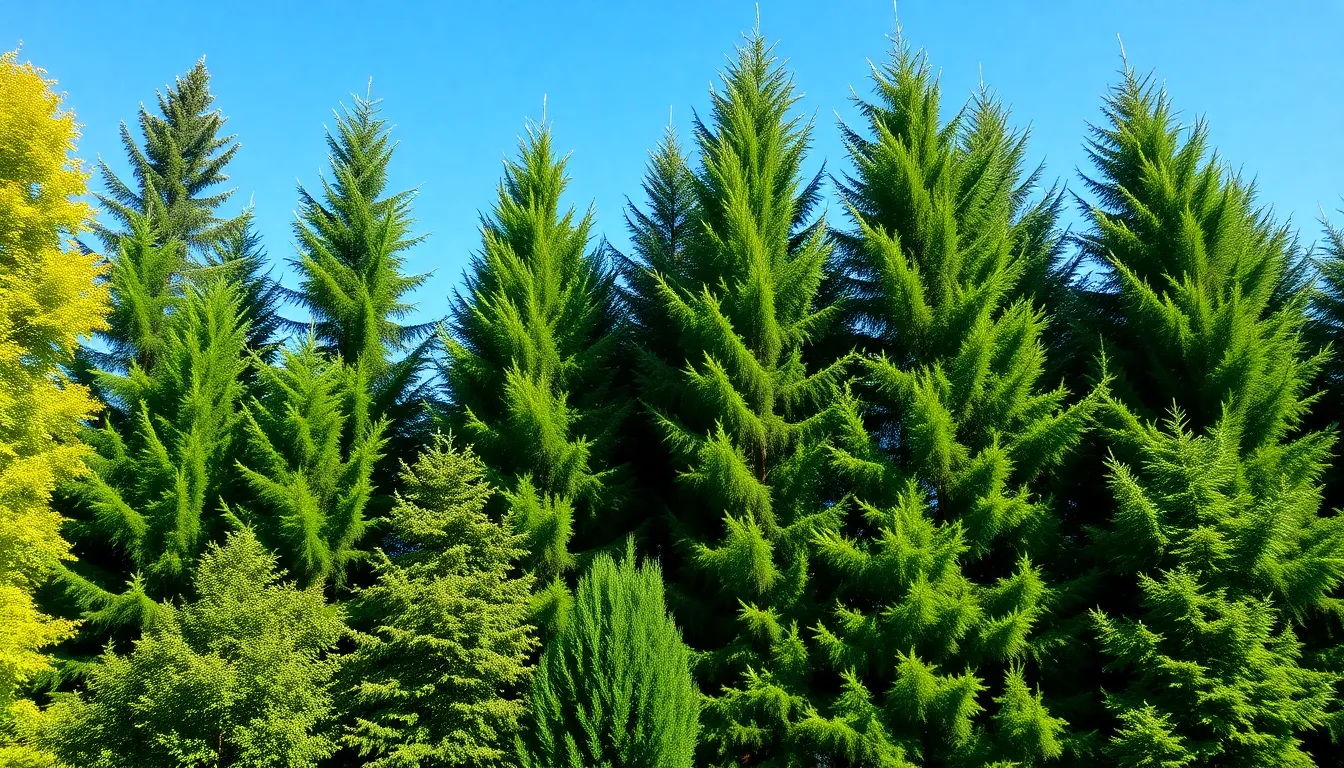
When we need taller answers for privacy and wind protection, evergreen trees deliver the height and density that shrubs simply can’t match. These majestic plants create living walls that shield our properties year-round while reducing energy costs.
Pine Trees for Natural Privacy Screens
Pine trees excel at creating impenetrable privacy barriers with their dense, needle-covered branches that stay lush throughout every season. We can plant them in strategic rows to effectively block unwanted views into our property while providing both visual and noise buffers from busy streets or neighboring homes. Their towering presence contributes significantly to energy efficiency by shading our homes during hot summer months and reducing heating costs in winter by blocking harsh cold winds.
Spruce Trees for Cold Climate Landscaping
Spruce trees thrive exceptionally well in colder climates where other species struggle to survive harsh conditions. Their dense, pyramidal shapes make them perfect windbreak answers that reduce wind chill effects and protect our buildings and gardens from damaging gusts. Wildlife benefits tremendously from spruce plantings since these trees provide critical habitat and food sources for birds during challenging winter months when other food becomes scarce.
Cedar Trees for Aromatic Boundary Planting
Cedar trees offer unique aromatic qualities that enhance our garden’s sensory experience while serving dual purposes as privacy screens and windbreaks. Their evergreen foliage creates dense borders that effectively repel noise pollution and establish beneficial microclimates that moderate extreme temperature fluctuations around our homes. Natural oils within cedar wood make these trees remarkably resistant to pests and decay, ensuring we enjoy low maintenance landscaping features that last for decades.
Incorporate Evergreen Perennials for Continuous Ground Coverage
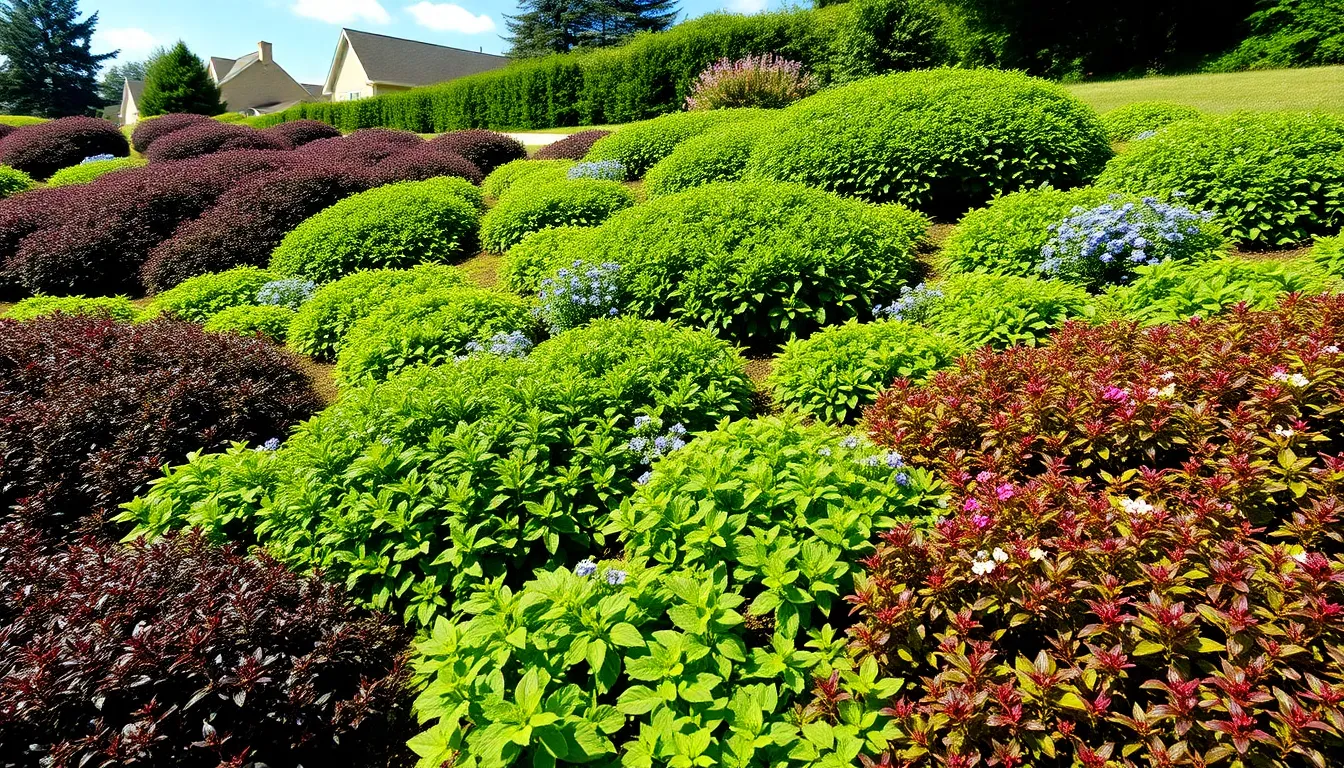
Evergreen perennials create the foundation layer of year-round landscaping by maintaining their foliage through all seasons. These hardy plants offer continuous ground coverage that complements the structural elements we’ve discussed while providing practical answers for challenging industry areas.
Pachysandra for Shaded Areas
Pachysandra thrives in the darkest corners of our gardens where other plants struggle to survive. This dense, carpet-forming perennial creates an elegant solution for areas under trees and alongside north-facing walls where sunlight rarely penetrates. We’ll find that pachysandra’s glossy green leaves form a thick mat that naturally suppresses weeds while requiring minimal maintenance once established.
Garden designers often recommend pachysandra for its soil-stabilizing properties in shaded slopes and woodland settings. The plant’s spreading root system anchors soil effectively while creating a uniform appearance that enhances the overall industry design. Property owners appreciate how pachysandra eliminates the need for constant weeding in difficult-to-reach shaded areas.
Vinca Minor for Slope Stabilization
Vinca minor excels at preventing soil erosion on slopes and embankments where traditional grass struggles to establish. This vigorous ground cover spreads rapidly through trailing stems that root at nodes, creating an interconnected network that holds soil in place during heavy rains. We’ve observed that vinca minor’s deep root system penetrates compacted soil more effectively than shallow-rooted alternatives.
Industry architects frequently specify vinca minor for its dual functionality of erosion control and ornamental appeal. The plant produces small, periwinkle-blue flowers throughout spring and summer, adding seasonal color to otherwise utilitarian slope plantings. Homeowners benefit from vinca minor’s ability to transform problematic hillsides into attractive industry features with minimal ongoing care.
Ajuga for Colorful Foliage Variety
Ajuga transforms ordinary ground cover into a ever-changing tapestry of colors and textures that changes with the seasons. This versatile perennial offers foliage variations ranging from deep burgundy and bronze to variegated green and white combinations that create visual interest even when the plant isn’t flowering. We can select from many ajuga cultivars to match exact color schemes and design preferences.
Spring brings dramatic vertical interest when ajuga sends up spikes of blue, purple, or white flowers that rise above the colorful foliage carpet. The plant’s compact growth habit makes it ideal for edging pathways, filling gaps between larger plants, or creating defined color blocks in mixed perennial borders. Gardeners appreciate ajuga’s tolerance for both sun and partial shade conditions, making it adaptable to various industry situations.
Plant Evergreen Ornamental Grasses for Texture and Movement
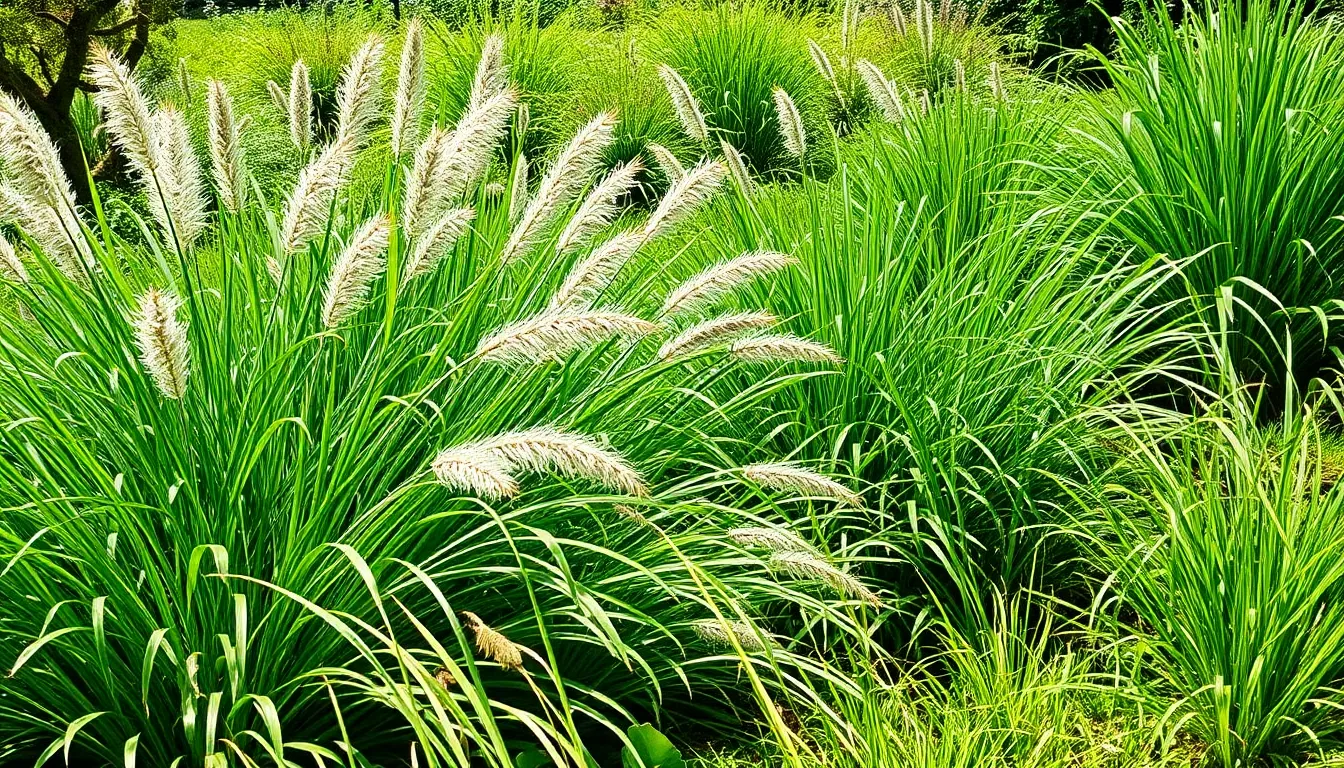
Beyond traditional evergreen trees and shrubs, ornamental grasses bring ever-changing texture and graceful movement to our year-round industry designs. These versatile plants maintain their visual appeal throughout all seasons while adding architectural elements that complement our existing evergreen foundation plantings.
Fountain Grass for Architectural Interest
Fountain grass creates stunning focal points with its feathery plumes and graceful arching form. We love how this popular evergreen ornamental grass provides structure and height variation in garden beds and borders, adding rhythm and softness to hardscaping elements. Its architectural interest comes from the contrast between its flowing blades and the more rigid forms of evergreen shrubs and trees.
This resilient grass thrives in various soil types and weather conditions, making it an excellent choice for our low-maintenance landscaping goals. We can use fountain grass to create natural transitions between different garden zones while maintaining the year-round appeal that defines successful evergreen landscaping.
Mondo Grass for Border Definition
Mondo grass excels as a low-growing evergreen ground cover that creates crisp, defined edges throughout our industry design. Its dense, dark green foliage provides clear lines and professional-looking borders around garden beds, walkways, and lawn areas. We appreciate how this versatile plant requires minimal maintenance while delivering maximum visual impact.
Thriving in shade to partial sun conditions, mondo grass fills gaps where other evergreen plants might struggle. We can count on its consistent performance to maintain clean borders and pathway definitions year after year, contributing to the polished appearance of our evergreen industry.
Sedge Varieties for Wet Soil Areas
Sedge varieties solve our challenging wet soil landscaping problems while maintaining the evergreen aesthetic we desire. These grass-like plants feature tufted, clumping growth habits that make them ideal for drainage-challenged and boggy areas where other evergreen plants might fail. We find sedges particularly valuable for their ability to provide consistent ground cover while preventing soil erosion.
Their evergreen foliage ensures our wet areas remain visually appealing throughout the year, eliminating the bare spots that can detract from our overall industry design. We can rely on sedge varieties to transform problematic wet areas into attractive industry features that complement our broader evergreen planting scheme.
Add Evergreen Vines for Vertical Landscaping Elements
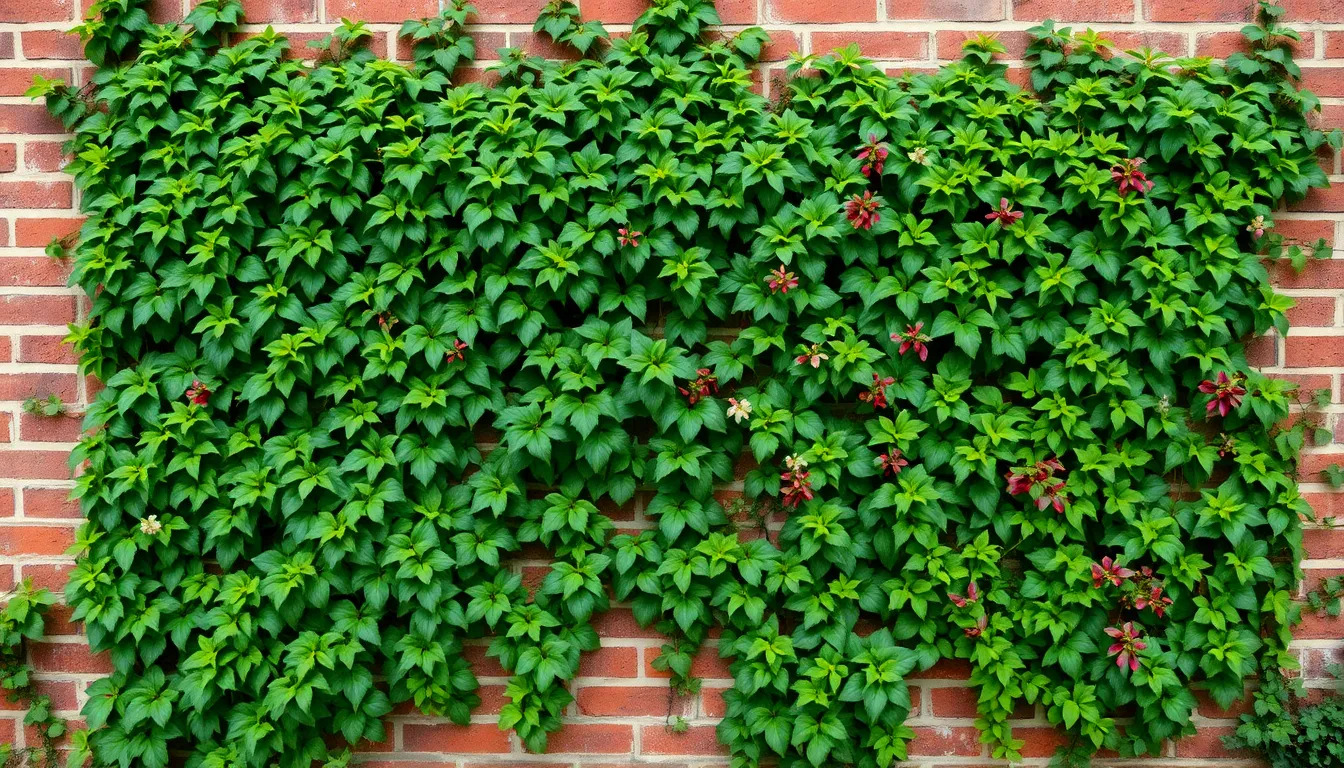
Evergreen vines transform vertical spaces into living walls that maintain their beauty throughout every season. These climbing plants offer the perfect solution for covering unsightly structures while creating privacy screens and adding architectural interest to your industry.
English Ivy for Wall Coverage
English Ivy creates stunning wall coverage that transforms bare surfaces into lush green tapestries. This classic evergreen vine clings tightly to walls and buildings, providing year-round vibrancy that never fails to impress. We recommend English Ivy for its ability to insulate buildings naturally while offering habitat for birds and beneficial insects.
Monitoring becomes essential with English Ivy to prevent potential masonry damage or unwanted spread. The dense foliage creates a dramatic visual impact that enhances any building’s exterior appearance. Property owners often choose this vine for its reliability and consistent performance across different climate conditions.
Climbing Euonymus for Fence Screening
Climbing Euonymus delivers versatile fence coverage that adapts to various light conditions throughout your property. Dense growth patterns make this evergreen vine ideal for creating privacy screens and blocking unsightly views effectively. We value its thick foliage that provides consistent year-round coverage, improving both privacy and aesthetic appeal.
Screening applications benefit from Climbing Euonymus’s ability to tolerate different environmental conditions. The vine’s adaptability makes it suitable for challenging spots where other plants might struggle. Homeowners appreciate how this evergreen maintains its lush appearance regardless of seasonal changes.
Wintercreeper for Versatile Growth Patterns
Wintercreeper offers exceptional adaptability as both ground cover and climbing vine, making it perfect for multiple industry applications. This Euonymus variety excels at covering slopes, walls, and fences with equal effectiveness. We appreciate its evergreen foliage that remains vibrant throughout winter months, providing consistent color and texture.
Versatility defines Wintercreeper’s appeal for property owners seeking multifunctional plants. The vine’s ability to adapt its growth pattern based on available support structures makes it incredibly valuable. Industry designers frequently specify this plant for its reliable performance and year-round visual interest.
Consider Climate-Specific Evergreen Plants for Regional Success
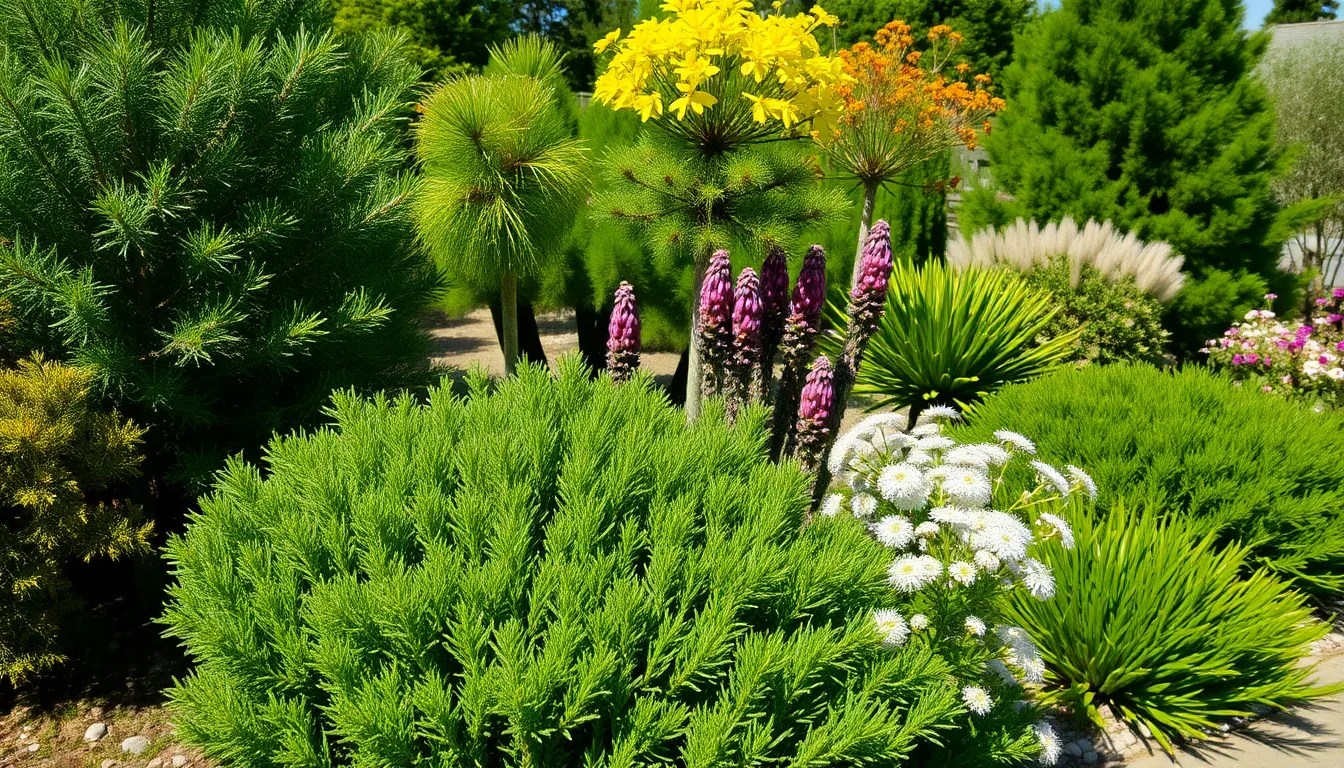
Selecting evergreens that thrive in your exact climate zone ensures successful landscaping with minimal maintenance. We’ll explore the best evergreen options for different regional conditions to help you make informed choices for your industry.
Cold-Hardy Evergreens for Northern Zones
Junipers dominate northern landscapes in USDA Hardiness Zones 3-9, offering steel-blue foliage that withstands harsh winters. These drought-tolerant conifers adapt to various soil types and require minimal pruning throughout the year. We recommend junipers for their versatility and ability to provide structure even during deep winter months.
Mugo Pine creates compact, cold-resistant additions perfect for rock gardens and borders. This hardy evergreen tolerates low temperatures while maintaining its attractive form year-round. Gardeners appreciate mugo pine’s minimal care requirements and reliable performance in northern climates.
Forsythia brings early spring color to Zones 5-8, tolerating cold climates exceptionally well. While technically deciduous, this plant provides valuable seasonal interest that complements evergreen plantings. We find forsythia particularly useful for adding bright yellow blooms when other plants remain dormant.
Heat-Tolerant Evergreens for Southern Climates
Chinese Fringe Flower (Loropetalum chinense) thrives in Zones 7-9, delivering colorful foliage year-round with bright pink spring blooms. This heat-loving evergreen performs best in full to partial sun with well-draining acidic soil. Southern gardeners value its ability to withstand high temperatures and humidity levels.
Indian Hawthorne (Rhaphiolepis indica) excels in warmer climates, requiring consistent watering during establishment before becoming drought tolerant. This evergreen provides reliable performance in southern regions where other plants struggle with heat stress. We recommend Indian hawthorne for its adaptability to various southern growing conditions.
Wintercreeper Euonymus tolerates heat and diverse soil types while featuring colorful foliage in greens, yellows, and purples. This versatile evergreen maintains its vibrant appearance throughout hot summers. Industry designers often choose wintercreeper for its reliable performance in challenging southern climates.
Drought-Resistant Evergreens for Arid Regions
Yucca species provide stiff, fan-shaped leaves with brutalist forms that require minimal water and pruning. These highly drought-tolerant evergreens grow in diverse soil types while adding striking vertical interest to xeriscaping projects. We value yuccas for their ability to thrive with minimal irrigation in water-conscious landscapes.
Junipers also excel in drought conditions, adapting to poor soils and requiring minimal watering after establishment. Their water-efficient nature makes them ideal for arid regions where conservation is essential. Industry architects frequently specify junipers for their low maintenance requirements in dry climates.
Mugo Pine performs exceptionally well in dry conditions with little ongoing maintenance. This drought-resistant evergreen maintains its attractive appearance without regular irrigation once established. We recommend mugo pine for homeowners seeking reliable evergreen coverage in water-restricted areas.
Plan Proper Spacing and Placement for Optimal Growth
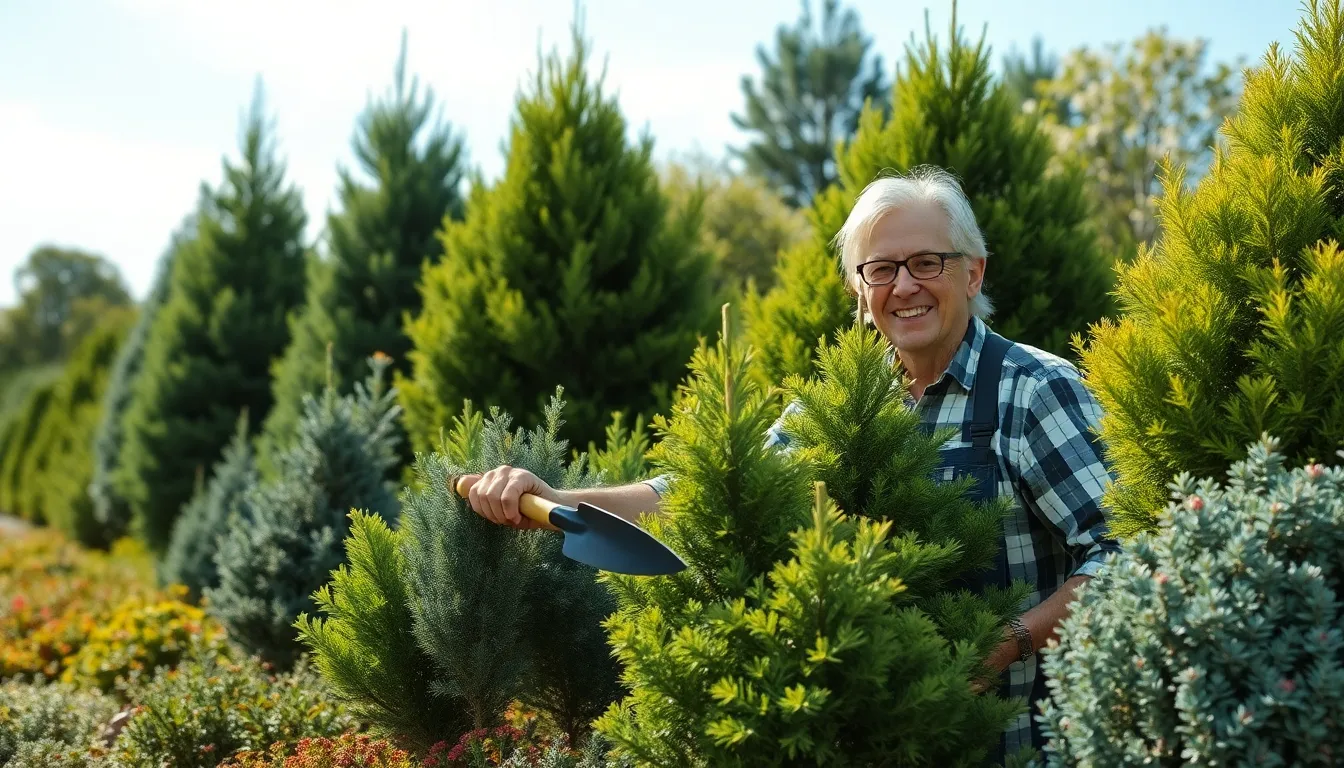
Strategic spacing and placement of evergreen plants ensures they’ll thrive without competing for resources or creating maintenance headaches down the road.
Understanding Mature Size Requirements
Evergreen plants vary dramatically in their mature dimensions, from compact 4-inch groundcovers to towering 100-foot specimens. We need to research each species’ exact growth habits before planting to avoid overcrowding issues later. Narrow boxwoods maintain their compact form, while expansive rhododendrons can spread several feet wide at maturity.
Knowledge of mature size prevents the common mistake of planting too closely together. Arborvitae varieties selected for privacy screens require adequate room to develop their full height and width without shading neighboring plants. Visual balance in our industry depends on understanding these growth patterns from the start.
Creating Layered Planting Designs
Layered planting creates depth and visual interest by positioning plants according to their mature heights. We place taller evergreens like pines or junipers at the back or center of planting beds to serve as anchors. Shorter shrubs and groundcovers such as boxwoods and mahonias work perfectly in foreground areas.
Broadleaf flowering evergreens like rhododendrons or Pieris japonica add texture variety to needle-bearing plants. These flowering species blend year-round foliage with seasonal bloom cycles, creating ever-changing visual layers. Strategic placement of different evergreen types ensures our industry maintains interest throughout all seasons.
Ensuring Adequate Sunlight and Drainage
Most evergreens thrive in well-drained soils with full to partial sun exposure, but exact requirements vary by species. Hardy varieties like junipers and pines adapt well to slopes and challenging conditions where drainage is naturally good. Rhododendrons prefer well-drained, acidic soils with dappled sunlight rather than harsh, direct exposure.
Proper site assessment prevents waterlogged areas that can kill evergreens and identifies spots with dense shade that limit growth. We must match each evergreen species with its preferred growing conditions to ensure healthy establishment. Avoiding areas where water pools after rain is crucial for most evergreen varieties’ long-term success.
Maintain Your Evergreen Landscape Investment Long-Term
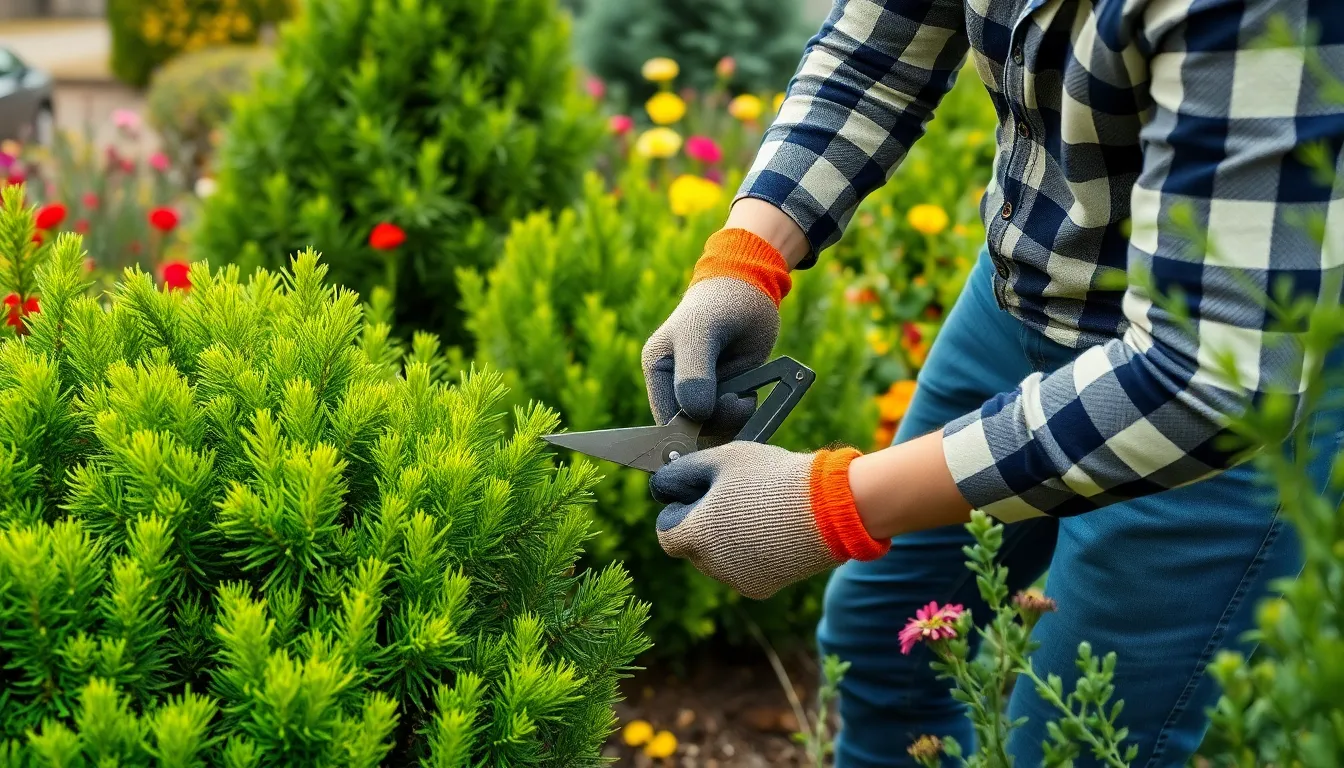
Protecting our evergreen investment requires consistent care and attention to detail throughout the seasons. These maintenance strategies ensure our industry continues to provide privacy, beauty, and value for years to come.
Seasonal Pruning and Shaping Techniques
Timing our pruning correctly makes all the difference for healthy evergreen growth. Late winter or early spring provides the optimal window before new growth begins, preventing damage to developing buds and branches.
Removing dead or diseased branches should be our first priority during any pruning session. This practice improves air circulation throughout the plant and promotes bushier, healthier growth patterns that enhance the overall appearance of our industry.
Sharp, clean tools are essential for making precise cuts that heal quickly. We should avoid heavy pruning into old wood since most evergreens don’t regenerate well from older stems, which can leave permanent gaps in our plants.
Regular light pruning maintains the clean shape and appropriate size for our industry design. This approach prevents our evergreens from overwhelming nearby plants or growing beyond their intended boundaries.
Fertilization and Watering Schedules
Early spring fertilization with balanced, slow-release products supports steady growth throughout the growing season. We should avoid over-fertilizing, which can stress plants and make them more susceptible to pest problems.
Newly planted evergreens need frequent watering during their first year to establish strong root systems. Deep watering encourages roots to grow downward, creating drought resilience that serves our plants well in challenging conditions.
Mature evergreens require watering mainly during dry spells or before winter freeze periods. Deep, infrequent watering proves more beneficial than frequent shallow watering, as it promotes deeper root development.
Winter preparation includes thorough watering before the ground freezes. This practice helps our evergreens withstand cold winds and drought stress during the dormant season when roots can’t absorb moisture from frozen soil.
Pest and Disease Prevention Strategies
Regular inspection for signs of pests like aphids, scale insects, or spider mites helps us catch problems early. We should also watch for diseases such as needle blight or root rot, which can quickly spread if left untreated.
Proper spacing and pruning maintain good air circulation, preventing fungal diseases that thrive in humid conditions. Cultural practices like these often eliminate the need for chemical treatments while keeping our evergreens healthy.
Water management plays a crucial role in disease prevention since wet conditions foster fungal infections. We should avoid overwatering and ensure our planting sites have adequate drainage to prevent root problems.
Appropriate horticultural oils or fungicides provide effective treatment when pest or disease issues appear. Following recommended application guidelines for exact problems ensures we address issues without harming beneficial insects or plant health.
Conclusion
We’ve shown you how evergreen plants can transform your industry into a year-round masterpiece that requires minimal maintenance. From towering pines that create natural privacy barriers to delicate perennials that carpet your garden floor these versatile plants offer answers for every landscaping challenge.
The key to success lies in selecting the right evergreens for your exact climate zone and understanding their mature growth requirements. Whether you’re dealing with harsh northern winters scorching southern summers or drought conditions there’s an evergreen variety that’ll thrive in your environment.
By investing in quality evergreen landscaping today you’re creating a foundation that’ll provide beauty structure and value for decades to come. Your outdoor space will remain vibrant and welcoming regardless of the season while requiring less water fertilizer and overall maintenance than traditional plantings.
Frequently Asked Questions
What are the main benefits of evergreen landscaping?
Evergreen landscaping provides year-round structure, color, and life to outdoor spaces when other plants lose their vibrancy in winter. They offer continuous privacy screening, windbreak protection, and aesthetic appeal with minimal maintenance requirements. Modern evergreen varieties also feature diverse colors and textures beyond traditional green needles.
Which evergreen shrubs are best for low-maintenance landscaping?
Boxwood shrubs are excellent for formal hedges with minimal care needs. Juniper varieties offer versatility and drought tolerance, making them ideal for various conditions. Rhododendrons provide colorful blooms while serving as effective privacy screens, combining beauty with functionality.
What evergreen trees work best for privacy and windbreaks?
Pine trees create impenetrable privacy barriers and enhance energy efficiency. Spruce trees excel in cold climates as effective windbreaks while providing wildlife habitat. Cedar trees offer aromatic qualities, noise reduction, and low maintenance, making them perfect for boundary planting.
How can evergreen perennials help with ground coverage?
Pachysandra thrives in shaded areas and naturally suppresses weeds. Vinca minor stabilizes soil on slopes while producing attractive periwinkle-blue flowers. Ajuga offers colorful foliage and seasonal blooms, adapting well to various growing conditions for continuous ground coverage.
What evergreen grasses add texture to landscapes?
Fountain grass provides architectural interest and creates stunning focal points with its graceful movement. Mondo grass effectively defines borders with dense foliage. Sedge varieties thrive in wet soil areas while preventing erosion and adding natural texture to landscape designs.
How do evergreen vines enhance vertical spaces?
English Ivy provides stunning wall coverage and insulation properties, though it requires monitoring to prevent structural damage. Climbing Euonymus adapts well to various conditions and creates effective privacy screens. Wintercreeper serves as both ground cover and climbing vine, offering consistent color year-round.
How do I choose climate-appropriate evergreens?
For northern zones, select cold-hardy options like Junipers, Mugo Pine, and Forsythia that withstand harsh winters. Southern climates benefit from heat-tolerant varieties like Chinese Fringe Flower and Indian Hawthorne. Arid regions require drought-resistant species such as Yucca and specialized Juniper varieties.
What spacing and placement considerations are important?
Understanding mature size requirements prevents overcrowding and ensures optimal growth. Create layered planting designs by positioning plants according to their mature heights. Most evergreens need well-drained soil with full to partial sun exposure, though specific species may have unique requirements.
How do I maintain evergreen plants long-term?
Perform seasonal pruning to promote healthy growth and maintain desired shapes. Follow proper fertilization schedules with balanced nutrients and deep watering practices. Conduct regular inspections for pests and diseases to address issues early and prevent major problems from developing.

